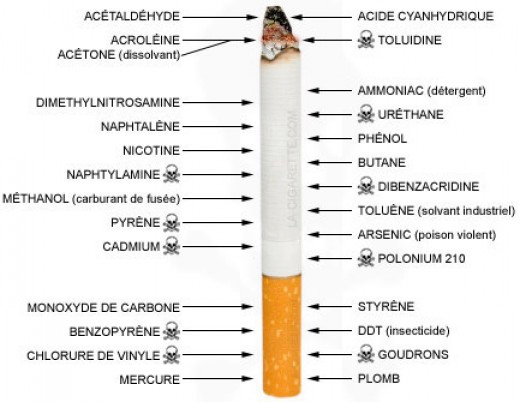
Tobacco companies knew that cigarette smoke contained radioactive alpha particles for more than four decades and developed “deep and intimate” knowledge of these particles’ cancer-causing potential, but they deliberately kept their findings from the public, according to a new study by UCLA researchers.
The analysis of dozens of previously unexamined internal tobacco industry documents, made available in 1998 as the result of a legal settlement, reveals that the industry was aware of cigarette radioactivity some five years earlier than previously thought and that tobacco companies, concerned about the potential lung cancer risk, began in-depth investigations into the possible effects of radioactivity on smokers as early as the 1960s.
“The documents show that the industry was well aware of the presence of a radioactive substance in tobacco as early as 1959,” the authors write. “Furthermore, the industry was not only cognizant of the potential ‘cancerous growth’ in the lungs of regular smokers, but also did quantitative radiobiological calculations to estimate the long-term lung radiation absorption dose of ionizing alpha particles emitted from cigarette smoke.” The study, published online Sept. 27 in Nicotine & Tobacco Research, the peer-reviewed journal of the Society for Research on Nicotine and Tobacco, adds to a growing body of research detailing the industry’s knowledge of cigarette smoke radioactivity and its efforts to suppress that information.
“They knew that the cigarette smoke was radioactive way back then and that it could potentially result in cancer, and they deliberately kept that information under wraps,” said the study’s first author, Hrayr S. Karagueuzian, a professor of cardiology who conducts research at UCLA’s Cardiovascular Research Laboratory, part of the David Geffen School of Medicine at UCLA. “Specifically, we show here that the industry used misleading statements to obfuscate the hazard of ionizing alpha particles to the lungs of smokers and, more importantly, banned any and all publication on tobacco smoke radioactivity.”
The radioactive substance — which the UCLA study shows was first brought to the attention of the tobacco industry in 1959 — was identified in 1964 as the isotope polonium-210, which emits carcinogenic alpha radiation. Polonium-210 can be found in all commercially available domestic and foreign cigarette brands, Karagueuzian said, and is absorbed by tobacco leaves through naturally occurring radon gas in the atmosphere and through high-phosphate chemical fertilizers used by tobacco growers. The substance is eventually inhaled by smokers into the lungs.
The study outlines the industry’s growing concerns about the cancer risk posed by polonium-210 inhalation and the research that industry scientists conducted over the decades to assess the radioactive isotope’s potential effect on smokers — including one study that quantitatively measured the potential lung burden from radiation exposure in a two-pack-a-day smoker over a two-decade period.
The cigarette companies knew about the lung cancer causing radiation, studied it and said nothing. And. despite knowing about the risk to its customers, declined to adopt techniques that could have helped eliminate the polonium-210 from the tobacco.
Despite the potential risk of lung cancer, tobacco companies declined to adopt a technique discovered in 1959 and then another developed in 1980 that could have helped eliminate polonium-210 from tobacco, the researchers said. The 1980 technique, known as an acid-wash, was found to be highly effective in removing the radioisotope from tobacco plants, where it forms a water-insoluble complex with the sticky, hair-like structures called trichomes that cover the leaves.
And while the industry frequently cited concerns over the cost and the possible environmental impact as rationales for not using the acid wash, UCLA researchers uncovered documents that they say indicate the real reason may have been far different.
“The industry was concerned that the acid media would ionize the nicotine, making it more difficult to be absorbed into the brains of smokers and depriving them of that instant nicotine rush that fuels their addiction,” Karagueuzian said. “The industry also were well aware that the curing of the tobacco leaves for more than a one-year period also would not eliminate the polonium-210, which has a half-life of 135 days, from the tobacco leaves because it was derived from its parent, lead-210, which has a half-life of 22 years.”
The Food and Drug Administration under the 2009 Family Smoking Prevention and Tobacco Control Act should force the cigarette companies to cleanse their product of these radioactive isotopes, emitting alpha particles.
Period.
Frankly, I don’t care if their product doesn’t deliver the nicotine kick or keeps their customers addicted. I do care that people are dying needlessly because of lung cancer caused by the product.
Karagueuzian said the earliest causal link between alpha particles and cancer was made in around 1920, when alpha particle-emitting radium paint was used to paint luminescent numbers on watch dials. The painting was done by hand, and the workers commonly used their lips to produce a point on the tip of the paint brush. Many workers accumulated significant burdens of alpha particles through ingestion and absorption of radium-226 into the bones and subsequently developed jaw and mouth cancers. The practice was eventually discontinued.
Another example involves liver cancer in patients exposed to chronic low-dose internal alpha particles emitted from the poorly soluble deposits of thorium dioxide after receiving the contrast agent Thorotrast. It has been suggested that the liver cancers resulted from point mutations of the tumor suppressor gene p53 by the accumulated alpha particles present in the contrast media. The use of Thorotrast as contrast agent was stopped in the 1950s.
Here is the abstract of the paper.
Introduction: To determine the tobacco industry’s policy and action with respect to radioactive polonium 210 (210Po) in cigarette smoke and to assess the long-term risk of lung cancer caused by alpha particle deposits in the lungs of regular smokers.
Methods: Analysis of major tobacco industries’ internal secret documents on cigarette radioactivity made available online by the Master Settlement Agreement in 1998.
Results: The documents show that the industry was well aware of the presence of a radioactive substance in tobacco as early as 1959. Furthermore, the industry was not only cognizant of the potential “cancerous growth” in the lungs of regular smokers but also did quantitative radiobiological calculations to estimate the long-term (25 years) lung radiation absorption dose (rad) of ionizing alpha particles emitted from the cigarette smoke. Our own calculations of lung rad of alpha particles match closely the rad estimated by the industry. According to the Environmental Protection Agency, the industry’s and our estimate of long-term lung rad of alpha particles causes 120–138 lung cancer deaths per year per 1,000 regular smokers. Acid wash was discovered in 1980 to be highly effectively in removing 210Po from the tobacco leaves; however, the industry avoided its use for concerns that acid media would ionize nicotine converting it into a poorly absorbable form into the brain of smokers thus depriving them of the much sought after instant “nicotine kick” sensation.
Conclusions: The evidence of lung cancer risk caused by cigarette smoke radioactivity is compelling enough to warrant its removal.

